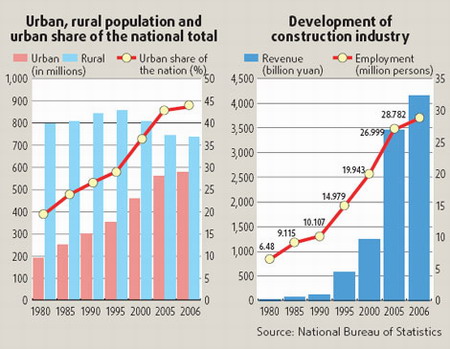
|
BIZCHINA> Wen's Lens
 |
|
Related
In with the new
By You Nuo (China Daily)
Updated: 2008-09-08 09:15
   People have long been arguing about the disappearance of China's old cities - whether it should not be so fast, and whether it should not be so cruel as to knock down the buildings that used to give Chinese cities their unique style. Nostalgia has been part of the urban dwellers' culture. Frequently, when the older cab drivers meet customers who speak with the distinctive "local flavor" they soon begin to compare notes about where they used to live - with the expectation that all homes were once within a bike ride from each other, and now many families, if not all, have moved at least once in the last 30 years from the city's central area to some distant, formerly obscure, suburban spots. Today's Beijing has indeed grown so large, and is so much a mixture of Chinese classic buildings and ultra-modern architectural designs, as the argument still continues about protecting traditional houses. In the meantime, the good thing is that the building industry has become one main pillar of the economy in terms of the capital investment and for the jobs it can create. The demand from the construction industry has also fueled rapid increases in the businesses of steel and cement. The change in the cities' skylines has also brought former rural workers into their first urban jobs. In the photo of workers having their lunch break at the construction site of the new headquarters for CCTV, the national television station, you may hear people greeting each other daily in more than five provincial accents. According to figures released at the end of 2006, all Chinese cities were able to accommodate some 577 million fully-registered residents, or around 44 percent of its entire population. But at this stage, China is still in an early stage of urban development. And the building of new houses and new public infrastructure in most cities other than Beijing and Shanghai is still lagging behind. Cities are being built in a markedly decentralized fashion, partly also because of the country's large land area. In comparison with South Korea, where half of its population and GDP are concentrated in Seoul, the capital city, Beijing, as the Chinese capital city, makes up only a little more than 3 percent of China's GDP.

(For more biz stories, please visit Industries)
|
主站蜘蛛池模板: 久久高清一级毛片 | 特级毛片8级毛片免费观看 特级毛片免费观看视频 | 日本免费一级视频 | 欧美特黄特色aaa大片免费看 | 在线精品视频播放 | 国产激情一级毛片久久久 | 最新版天堂资源中文官网 | 亚洲色吧| 久久99精品久久久久久 | 国产成人精品福利网站在线 | 久久成人a毛片免费观看网站 | 日本欧美久久久久免费播放网 | 国内精品不卡一区二区三区 | 美女一级ba大片免色野外 | 亚洲国产影院 | 国产成人免费网站 | 日韩欧美亚州 | 分享一个无毒不卡免费国产 | 久久久精品视频免费观看 | 国产精品亚洲精品日韩已满 | 毛片免费观看的视频 | 在线亚洲精品国产波多野结衣 | 国产成人精品s8p视频 | 韩国美女豪爽一级毛片 | 高清欧美一级在线观看 | 九九视频在线观看6 | 午夜美女久久久久爽久久 | 国产亚洲精品一区二区久久 | 免费特级毛片 | 中文字幕成人免费视频 | 国产一级视频在线观看 | 欧美黑粗特黄午夜大片 | 怡红院美国十次成人影院 | 日本高清不卡中文字幕 | 成人禁在线观看网站 | 91九色首页| 久久中文亚洲国产 | 久久精品视频观看 | 国产第二页 | 99久久免费看精品国产一区 | 亚洲va中文字幕欧美不卡 |